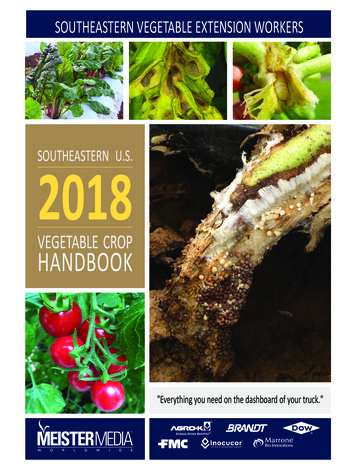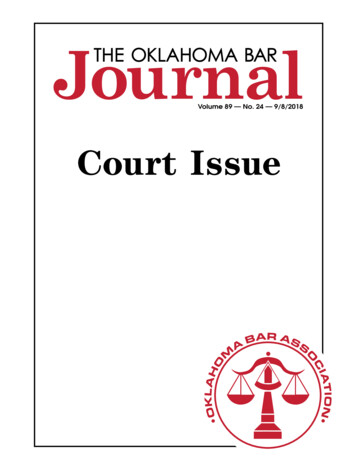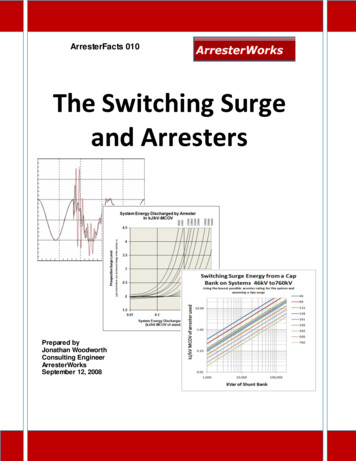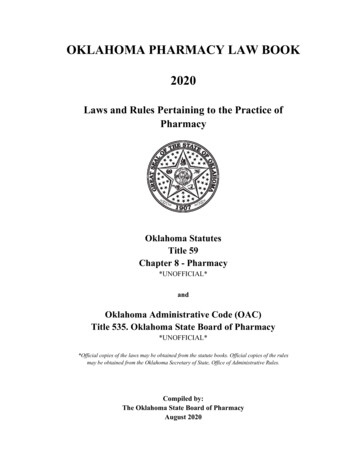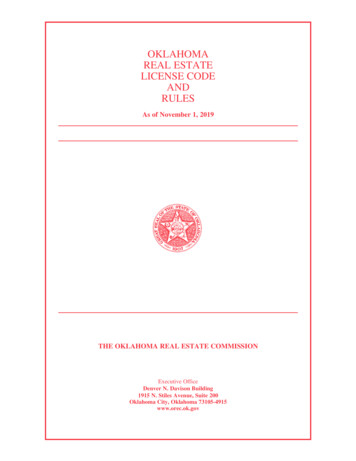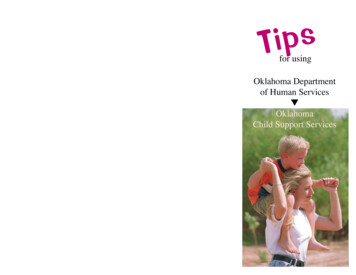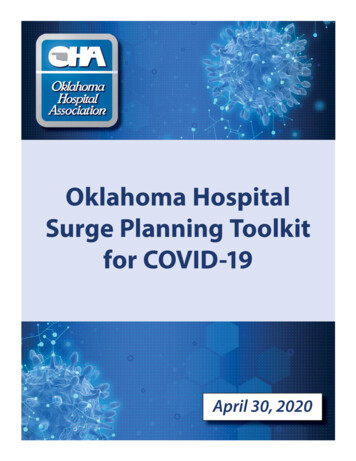
Transcription
Oklahoma HospitalSurge Planning Toolkitfor COVID-19April 30, 2020
Table of ContentsOverview.3Key Definitions.3Duty to Plan.4Planning Assumptions.5Oklahoma COVID-19 Hospital Plan for Patient Care Settings - A Toolkit .5Overview Planning and Preperation for Surge in Hospitals.5Oklahoma Regional Infrastructure.5Eight Geographic Preparedness Regions .6EMResource.9TReC (Trauma Transfer and Referral Center).9Surge Plan.9Surge Plan Pillars.10Operations.10Logistics.11Clinical Care.12Resources.13Long Term Care Discharge Guidance.14Telemedicine.14Overview.14Market Assessment and Engagement for Placement of Carts.15Cart Distribution and Service Orientation.16Mental Health and Telemedicine.16Telephone Codes Reimbursable Through OHCA.16Mental Health and Substance Abuse.16Telemedicine Resources.16Scarce Resource Management and Crisis Standards of Care.17Introduction.17Oklahoma Model Crisis Standards of Care.18State Executive Orders and Federal Waivers.19Acknowledgements.20This document may be revised and updated as plans and information related to the pandemic evolve.Refer to www.okoha.com for updates.2
OVERVIEWThis document has been developed to assist Oklahoma hospitals and clinicians during the 2020 COVID-19 pandemic. As directedby Gov. Kevin Stitt, the Oklahoma Hospital Association was tasked with the development of a hospital surge plan with support ofthe governor’s COVID-19 Solutions Task Force. The assumptions in this document are based on a model created by the Institute ofHealth Metrics and Evaluation (IHME) at the University of Washington.The Oklahoma statewide plan for a hospital surge of COVID-19 patients is developed using a regional approach to maximize thefull potential of hospital resources. The plan utilizes the existing eight homeland preparedness/trauma regions throughout thestate to maximize existing working relationships between emergency response and hospitals as well as organize resources by theRegional Medical Response System (RMRS) for state and federal allocation of personal protective equipment and other supplies.The planning process in this plan is organized by a tiered process. Tier 1 is a timeframe when hospital operations are planning foran imminent surge of COVID-19 patient. Tier 2 occurs when the hospital is seeing a surge of patients and has not moved to a critical state but is preparing for staffing beyond 100% capacity. Tier 3 is when a hospital is in a surge situation and working beyond100% capacity (see definitions on next page). When hospitals begin to reach surge capacity of 140%, state government will initiatethe use of alternative care sites. Tier 4 is when the hospital surge has decreased and is normalizing to pre-COVID-19 status.It is further organized in pillars that include: operations, logistics, clinical care and resources. There are resources for each tier inthese pillars.Ideally, this document would have been developed through a deliberative process involving many stakeholders and reviews. Theneed for established guidance at this critical time necessitated the expedited development of a framework for Oklahoma hospitals. However, many hospital CEOs were consulted regarding assumptions and surveys that are embedded within this model.Many hospitals have a well-developed surge plan and crisis standards process. This document is not intended to prescribe surgeand crisis planning nor take the place of individual plans. It is meant to help hospitals consider interventions and provide resources for quick reference.Key DefinitionsConventional capacity: The spaces, staff, and supplies used are consistent with daily practices within the institution. Thesepractices are typically adequate for a major mass casualty incident within the immediate area of the facility, even one that triggersactivation of the facility emergency operations plan.Contingency capacity: The spaces, staff, and supplies used are not consistent with daily practices, but provide care to a standard that is functionally equivalent to usual patient care practices. These practices may be used temporarily during a major masscasualty incident or on a more sustained basis during a disaster that puts strain on the system or region (when the demands of theincident exceed community resources).Crisis capacity: Adaptive spaces, staff, and supplies are not consistent with usual standards of care, but provide sufficiency ofcare in the setting of a catastrophic disaster (i.e. provide the best possible care to patients given the circumstances and resourcesavailable). Crisis capacity activation constitutes a significant adjustment to standards of care and typically occurs with a national orglobal event such as the COVID-19 response.EMResource : A web-based information and resource management tool that has been adapted to collect real-time data on hospital capacity and capability, and includes ventilator, PPE and other resources for Oklahoma’s COVID-19 response.3
MERC: During a response, the regional MERC (Medical Emergency Response Center), operating under the direction of the Regional Medical Response System, is designed to operate as a multi-agency coordination center that represents the greater healthcare community. Their role includes promoting and facilitating the sharing of incident and response information and resourcesbetween health care organizations, and coordinating support through an established and operational interface between healthcare organizations and the relevant jurisdictional agency(ies).TReC: Trauma Transfer and Referral Center. Initially, TReC was established as a communication center for ambulance servicestransporting pre-hospital patients or transferring patients inter-facility whereby TReC must be contacted for transfer within metropolitan areas. For the COVID-19 response, TReC will become the center for requested transfers.Surge: Ability to provide adequate medical evaluation and care during events that exceed the limits of the normal medical infrastructure of an affected community. In the Oklahoma plan, the definition of surge is 40% over 100% capacity of normal.Level of Surge DescriptionsTier 1: The surge of patients is such that the hospital mobilizes its existing on-site human and materiel resources. The hospitalbegins strategies to plan for additional patients and conserves resources.Tier 2: The surge of patients is such that the hospital needs to consider the deployment of additional human and materiel resources without changing the traditional standard of care, to prepare for 100% capacity. The trigger for this consideration is a 60%occupancy of normally staffed beds, increasing cases in the community and continued admissions. Incident Command may beactivated and normal operations may be affected, e.g., cancellation of elective admissions and procedures, and conservation ofresources.Tier 3: The surge of patients is such that the traditional standard of care may be affected due to limited resources at the hospitaland the inability of the hospital to transfer patients to other hospitals. The hospital conserves resources and may use the CrisisStandards of Care to assist in making conservation decisions. Normal operations may be significantly affected. The use of alternatecare sites may be considered.Tier 4: The hospital surge has decreased and is normalizing to pre-COVID-19 status.Duty to PlanHospitals must develop plans for moving from Tier 1 to Tier 3. During a disaster or declared emergency, the goal is to remain inTier 1 status to the extent possible and avoid moving to Tier 3. Strategies for remaining in the lower tiers may include: Canceling elective procedures and surgeries to increase capacity.Early discharge or transfer of appropriate patients to home or less acute levels of care.Transferring less acute patients from medical surgical units to alternate care sites, with the assistance of case managers anddischarge planners.Transferring post-acute and behavioral health patients from acute settings into other appropriate settings.Expanding critical care capacity into areas such as post-anesthesia care units, surgical suites, outpatient care units.Expanding patient care areas to include hallways and private rooms.Expediting admissions to move patients from the emergency department to patient care units.EMTALA compliant screening of individuals seeking care, in coordination with EMS or other medical direction, to determinethe most appropriate setting for care including an established alternate care site for less acute patients.4
Planning AssumptionsPlanning assumptions specific for the COVID-19 pandemic include the following: Adjusted staffing ratios and roles will be needed to extend and maximize care.Staff availability will be reduced due to COVID-19 exposure and illness, quarantine, exhaustion and personal decisions to notreport for duty.There could be insufficient beds for all patients needing inpatient and especially critical care.There could be insufficient personal protective equipment for health care workers.The majority of infected patients can be treated at less acute levels of care or at home.The number of patients requiring hospital care could exceed the current capacity of Oklahoma hospitals.Oklahoma COVID-19 Plan forPatient Care SettingsOverview: Planning and Preparing for Surge in HospitalsUnder the direction of the governor’s COVID-19 Task Force and in partnership with the Oklahoma Hospital Association, OklahomaState Department of Health, and the Oklahoma National Guard, a surge plan for the state of Oklahoma was created that includesthe current health care system and alternate care sites. Planning includes surge over 40% capacity, the evaluation of current resources, and adaptation of the current regional infrastructure to address COVID-19.Oklahoma Regional InfrastructureThere are three components of current regional infrastructure that have been adapted for the COVID-19 response: eight geographic preparedness regions, EMResource, and TReC (Trauma Transfer and Referral Center).Oklahoma’s Eight Geographic Preparedness RegionsOklahoma is divided into eight geographic regions utilized by the Oklahoma Office of Homeland Security and the Oklahoma StateDepartment of Health for the purpose of planning, protecting, providing funding and responding to an incident. Hospital capacity and capability was evaluated to determine resources available to care for the COVID-19 patient at the closest, most appropriatehospital with the resources available to care for the patient. Region 1 is NW Oklahoma, Region 2 is NE, Region 3 is SE, Region 4 isEast-Central, Region 5 is SE, Region 6 surrounds Oklahoma County, Region 7 is Tulsa County, and Region 8 is Oklahoma County(see maps, next page). The Oklahoma Hospital Association conducted an assessment of current ventilator resources in each regionand compiled the information contained in the surge plan.5
Current Infrastructure:8 Preparedness RegionsTrauma Regions and Hospitalsby Trauma LevelOklahoma 2019In the following regional information: Hospital resource data was obtained through an OHA survey. Total vents: Number of full feature ventilators (including BiPap and anesthesia machines) immediately available for use.6
7
8
EMResourceIn Oklahoma, EMResource has been used for 20 years to coordinate and communicate capacity and resources by hospitals andemergency medical services. EMResource is a web-based information and resource management tool that has been adapted tocollect real-time data on hospital and EMS capacity and capability, including ventilator, PPE and other resources for Oklahoma’sCOVID-19 response. Daily queries and updating of current information provide the most accurate source of information for operational decision making. All Oklahoma acute care hospitals and EMS agencies have access to entering data into EMResource. Thisdaily data reported to EMResource by hospitals is the basis for PPE/resource allocation.TReC- Trauma Transfer and Referral CenterThe Trauma Transfer and Referral Center (TReC) was established by statute OS §63-1-2530.8. – Rule: OS 310:641-3-130 to ensuretrauma patients go to the closest, most appropriate hospital, reduce over and under-triage, preserve resources for those that needthem the most, and to help limit demand on scarce specialists.The TReC has been adapted to the COVID-19 response to transport/transfer COVID ( ) patients to the closest, most appropriatefacility within their region if capacity/capability exists and facilitate referral of COVID ( ) patients requiring a higher level of care tothe closest, most appropriate facility.Surge PlanIntroductionA tiered action plan for surge was created to define “trigger points,” based upon hospital capacity for implementation of actionsto maximize resources. This action plan is not intended to replace surge plans prepared by individual hospitals, but acts as a guidefor hospitals. The defined Tiered Action Plan Triggers provides an overall statewide view of hospital capacity and capability.For the Oklahoma Hospital Surge Plan, go to https://bit.ly/3breKRX.9
The Oklahoma Hospital Surge Plan is dividedinto four “pillars” with components relative tothe COVID-19 response. Each component hasbeen assessed and resources developed forstatewide planning and for hospital use.Operations: addresses staffing, ICU and medsurg beds, alternative care models;Logistics: addresses facilities, transportation,health care worker wellness;Clinical Care: guidelines for provision of care,referral to a higher level of care, EMS medicaldirection, telemedicine;Resources: human, supply chain and equipmentitems required to implement surge plan.Surge Plan PillarsComprehensive Hospital Preparedness Checklist for Coronavirus Disease COVID-19 – https://bit.ly/2W18w50.Emergency Department SurgePre-Crisis Planning-Emergency Medical Treatment and Labor Act (EMTALA) Requirements and Implications Related toCoronavirus Disease 2019 – The Centers for Medicare & Medicaid Services (CMS) memorandum conveys information in responseto inquiries from hospitals and critical access hospitals concerning implications of COVID-19 for their compliance with EMTALA.This guidance applies to both Medicare and Medicaid providers. To learn more, go to https://go.cms.gov/34RCAUy.To access more resources, go to the ASPR TRACIE COVID-19 Emergency Department Resources Page, https://bit.ly/2RVplwU.10
Critical CareCritical Care Planning - COVID-19 Quick Notes – This document outlines actionable steps hospitals can take to operationalizecritical care planning in areas such as space, staffing, supply, and provision of care. To learn more, go to https://bit.ly/34Rcj8O.For additional Critical Care Resources go to https://bit.ly/3bthH4r.StaffingSurge Priority Planning COVID-19: Critical Care Staffing and Nursing Considerations – This document provides guidance toensure the safety and resilience of nursing staff during a pandemic-related surge. The suggestions in this article are focused onnursing leadership and administrative considerations, strategies for optimizing staffing resources, and maintaining staff safetyand resilience. To learn more, go to https://bit.ly/34Tj89R.Strategies to Mitigate Health Care Personnel Staffing Shortages – This information is for health care facilities that may be experiencing staffing shortages due to COVID19. It outlines contingency capacity strategies to mitigate staffing shortages. To learnmore, go to https://bit.ly/3avdzzz.COVID-19 Behavioral Health Resources – The resources in this collection were created by federal agencies and their partners tohelp health care providers, caregivers, and the general population prepare for and manage the negative behavioral effects thatcan accompany a public health emergency. To learn more, go to https://bit.ly/2XVbMl4.Mitigate Absenteeism by Protecting Health Care Workers’ Psychological Health and Well-beingduring the COVID-19 Pandemic – The actions listed in this document can help health care facility leaders protect workers’ psychological health and well-being. To learn more, go to https://bit.ly/2Knmg4y.Fit-Testing for N95 Filtering Facepieces During the COVID-19 Outbreak – This memorandum provides temporary enforcement guidance to compliance safety and health officers for enforcing the Respiratory Protection standard, 29 CFR § 1910.134, withregard to supply shortages of N95 filtering facepiece respirators due to the COVID-19 pandemic. To learn more, go tohttps://bit.ly/2xBxfVn.11
Proper N95 Respirator Use for Respiratory Protection Preparedness – The National Institute for Occupational Safety andHealth (NIOSH) Science Blog offers some strategies for identifying the best respirator fit. To learn more, go to https://bit.ly/34TNkli.Sequence for Putting on Personal Protective Equipment (PPE) – This document provides a PDF of the sequence to properlydon and doff PPE. To learn more, go to https://bit.ly/2RTSyIH.What Health Care Personnel Should Know about Caring for Patients with Confirmed or Possible COVID-19 Infection – Thisdocument details how to protect oneself when treating patients who are confirmed or possible COVID-19 patients. It includessteps for environmental cleaning, disinfection and guidance when an individual should contact occupational health services. Italso includes a guide on interim infection and prevention control for patients with, or suspected of having, COVID-19 in healthcare settings. To learn more, go to https://bit.ly/3cwyyU4.Just in Time (JIT) Skills Training Videos for COVID-19 – These videos are provided to support preparedness training activitiesand provide JIT training for all frontline, assessment, and treatment facilities caring for a patient suspected or confirmed to beinfected with COVID-19. Topics include: Laboratory Specimen Collection: Nasopharyngeal Swab, https://bit.ly/2zckAsa Personal Protective Equipment for 2019 Novel Coronavirus (COVID-19), https://bit.ly/3eOOUJYTo learn more, go to https://bit.ly/2xMEpGg.Interim U.S. Guidance for Risk Assessment and Public Health Management of Health Care Personnel with PotentialExposure in a Health Care Setting to Patients with COVID-19 – This interim guidance is intended to assist with assessment ofrisk, monitoring, and work restriction decisions for HCP with potential exposure to COVID-19. To learn more, go tohttps://bit.ly/3bsLKtc.Criteria for Return to Work for Health Care Personnel with Confirmed or Suspected COVID-19 (Interim Guidance) – Thisinterim guidance is for health care leadership and officials making decisions about return to work for health care personnel withconfirmed COVID-19, or who have suspected COVID-19 (e.g., developed symptoms of a respiratory infection [cough, sore throat,shortness of breath, fever], but did not get tested for COVID-19). To learn more, go tohttps://bit.ly/34SyQlL.12
Clinical CareAdult COVID General Admission Orders, https://bit.ly/2VornI2CDC: COVID Decontamination and Reuse of Filtering Facepiece Respirators, https://bit.ly/2RUpAYUOklahoma City Homeless Shelters, https://bit.ly/2RWVCUdOSDH Standards for Identification of Human Remains with Transmissible Disease, https://bit.ly/2yBZZ03OUMC COVID Treatment Protocol, https://bit.ly/2ytg3S2Respiratory Management of COVID-19 Patients, https://bit.ly/3eBDCIZSurviving Sepsis Campaign: Guidelines on the Management of Critically Ill Adults with Coronavirus Disease 2019(COVID-19), https://bit.ly/2RWU7FISSC Infographic – Summary of recommendations on the management of patients with COVID-19 and ARDS,https://bit.ly/2XSquZPHospital Personal Protective Equipment Planning Tool – This tool is designed to help hospitals determine approximate PPEneeds based on special pathogen category and a number of facility specific variables. Calculators are included for Ebola VirusDisease/Viral Hemorrhagic Fever (EVD/VHF), as well as special respiratory pathogens such as Middle East Respiratory Syndrome/Severe Acute Respiratory Syndrome (MERS/SARS), and for pandemic influenza. To learn more, go to https://bit.ly/2XUINhc.Personal Protective Equipment (PPE) Burn Rate Calculator – The PPE Burn Rate Calculator is a spreadsheet-based model thatprovides information for health care facilities to plan and optimize the use of PPE for response to COVID-19. Similarly, non-healthcare facilities (e.g., correctional facilities) may find this tool useful for planning and optimizing PPE use, as part of the response toCOVID-19. To learn more, go to https://bit.ly/3asPFF3.13
Decontamination and Reuse of Filtering Facepiece Respirators using Contingency and Crisis Capacity Strategies – Disposable filtering facepiece respirators (FFRs) are not approved for routine decontamination and reuse as standard of care. However,FFR decontamination and reuse may need to be considered as a crisis capacity strategy to ensure continued availability. This document summarizes research about decontamination of FFRs before reuse. To learn more, go to https://bit.ly/2Vpm9vs.Strategies to Optimize the Supply of PPE and Equipment – This CDC guidance lists strategies to optimize the following equipment, eye protection, isolation gowns, facemasks, N95 respirators, PPE, and ventilators. It also includes the PPE Burn Rate Calculator listed above. To learn more, go to https://bit.ly/2VS5jom.Strategies to Optimize Ventilator Use during the COVID-19 Pandemic – The U.S. Department of Health and Human Services(HHS) and the Federal Emergency Management Agency (FEMA) are working with multiple partners, including health care systems,academic institutions, professional medical societies, and the National Academies of Science, Engineering and Medicine, to develop crisis standards of care strategies for ventilator support when resources are limited. To learn more, go to https://bit.ly/2RV4F82.To access more resources, review the ASPR TRACIE COVID-19 Supply Chain Resources page, https://bit.ly/3bqvZTr.Long Term Care Discharge GuidanceThe Oklahoma State Department of Health, in coordination with OHA, created guidance for the discharge of hospitalized patientsto long term care facilities (LTC). The guidance addresses the appropriate LTC destination for patients and pre-discharge COVID-19testing requirements. The Hospital Discharge to LTC Guidance can be found at https://bit.ly/3aEzqVr.TelemedicineOverviewThe Centers for Medicare & Medicaid Services (CMS) and SoonerCare, along with most commercial payors, have relaxed and/orwaived many restrictions around provision of telemedicine services for the COVID-19 pandemic. Telemedicine services are highlyrecommended in cases where patients are medically stable and able to quarantine in their home setting. Telemedicine servicesare also recommended for all other patients to promote decreased exposure, particularly for those in the at-risk category. Telemedicine may be provided through tele-monitoring, virtual visit, e-visit or by phone, all with varying options for the type of medical care allowed. Patients must consent verbally to telemedicine services and this must be documented in the patient’s medicalrecord. Patients and family members should receive guidance and education on telemedicine options and how to use the chosenoption. For further guidance on Oklahoma issues from reimbursement to licensure on telemedicine, please see the OHA overviewdocument, “Telehealth in Oklahoma During COVID-19,” https://bit.ly/2RCl3dM.A problem identified early in the Oklahoma hospital surge planning process was the need for specialists or assistance of intensivists due to possible fatigue during the COVID-19 pandemic in rural or critical access hospitals not affiliated with hospital systems.Deployment of telemedicine to hospitals with the need for equipment will keep patients in their communities and keep all possible COVID patients in a stable acute environment without transport to an urban center, while transportation and PPE are scarcestatewide during the pandemic.Breadth of problemOklahoma State University Center for Health Sciences (OSUCHS) administers the federal FLEX and SHIP grants for 54 rural hospitals, and through the OSU Center for Rural Health has been supporting these hospitals as they prepare and update their IncidentCommand Center protocols and community readiness for the COVID-19 pandemic. The center believes there would be interest14
among the Small Rural Hospital Improvement Program (SHIP) recipients for some level of telemedicine assistance, and a considerable number of these hospitals are not part of a larger integrated hospital system. OHA, as par
Tier 1 is a timeframe when hospital operations are planning for an imminent surge of COVID-19 patient. Tier 2 occurs when the hospital is seeing a surge of patients and has not moved to a crit-ical state but is preparing for staffi ng beyond 100% capacity. Tier 3 is when a hospital is in a surge situation and working beyond


